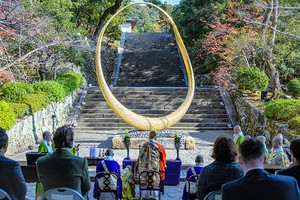By WAKATO ONISHI/ Senior Staff Writer
September 18, 2023 at 07:00 JST
TAKAMATSU--Dementia has not slowed the creations of painter Kaoru Ueda, who is known for his photographic-like renderings of objects, such as a raw egg trickling out of its shell.
Ueda, 94, fell into dementia about two years ago. He continues to draw and paint at his home in Kanagawa Prefecture, where he is under treatment.
His latest works are characterized by their unsophistication, in a sharp departure from the exquisite pieces of his earlier years, when his pieces appeared in school textbooks on the fine arts.
The change has provided much fodder for discussion, including among visitors to his one-man show, which is running at the Takamatsu Art Museum, in this capital of Kagawa Prefecture, through Sept. 18.
“People often say they are sorry for us when we tell them that my husband has dementia,” said Yoko, the painter’s wife. “But the pictures he draws look so joyful. I am curious to see what people think of them at the exhibition.”

Paintings in Ueda’s familiar touch, including an image of glossy and dewy jelly on a spoon, are followed, at the exhibition venue, by an image of a thicket of trees done in a melange of colors and shapes, a rough-hewn self-portrait in pencil, drawings of lovely insects and fish, among other works.
The show is thus featuring oeuvres that carry his hallmark style, known as hyperrealism, along with more than 30 pristine sketches that he has done in sketchbooks and elsewhere while under medical treatment in 2021 and later.
The exhibition was planned around a pair of Ueda’s realistic masterpieces owned by the museum, which are a favorite of visitors. The painter’s recent works, however, look quite different.
Visitors have described his latest works as being “lovely,” “amusing” and “buoyant,” according to Tomoko Ishida, a curator with the museum.
Ueda studied oil painting at the Tokyo University of the Arts, and he started out as an abstract painter and a professional designer.
He began implementing the technique of hyperrealism, also known as superrealism and photorealism, sometime around 1970 and earned recognition for that approach, whereby the painter accurately traces a photo image projected onto a screen.
Ueda began showing signs of dementia while he was in the hospital after he underwent heart surgery in November 2020.

He is no longer capable of the elaborate expressions of his earlier years, but he has since been using colored pencils and other tools to draw and paint pictures of a naive touch.
The exhibits include drawings of a conch shell and a hermit crab.
Those objects served as a watershed for Ueda’s conversion to hyperrealism decades ago. His latter-day renderings of the same subjects, which he modeled on the real thing and an image in an illustrated reference book, remain as realistic as his works of bygone years.
“Dementia does not spell the end of everything,” Yoko said. “The essential thing is to keep doing what little you can do. I think you still have a lot of potential, even when you can no longer maintain a normal social life. I hope people will see that he is just like that.”

She said Ueda can engage in quite a bit of conversation when he is in relatively good shape.
Ishida, the curator, also praised the painter’s latest works.
“Despite the variety of limitations he faces, Ueda still retains the ability to make these arresting and lively pictures,” she said. “These works have shown he still has this urge to draw and paint and his style of expression has changed.”
Ishida said she has not heard any negative reaction at the exhibition venue.
“Oh, a painter never ceases to be a painter,” she said, citing one viewer's feedback. “The way he continues to work is so moving,” said another.
Ueda’s new approach to realism is certainly coming across to exhibition visitors.




















A peek through the music industry’s curtain at the producers who harnessed social media to help their idols go global.
A series based on diplomatic documents declassified by Japan’s Foreign Ministry
Here is a collection of first-hand accounts by “hibakusha” atomic bomb survivors.
Cooking experts, chefs and others involved in the field of food introduce their special recipes intertwined with their paths in life.
A series about Japanese-Americans and their memories of World War II